
国内图书分类号:TP242.3 学校代码:10213 国际图书分类号:629.127 密级:公开 工学博士学位论文 基于肌肉性静水骨骼原理的机器乌贼原型 关键技术研究 博士研究生:杭观荣 导 师:王振龙教授 申请学位:工学博士 学 科:机械制造及其自动化 所在单位:机电工程学院 答辩日期:2009年6月 授予学位单位:哈尔滨工业大学
国内图书分类号:TP242.3 学校代码: 10213 国际图书分类号:629.127 密级: 公 开 工学博士学位论文 基于肌肉性静水骨骼原理的机器乌贼原型 关键技术研究 博士研究生:杭观荣 导 师:王振龙教授 申请学位:工学博士 学 科:机械制造及其自动化 所 在 单 位:机电工程学院 答 辩 日 期:2009 年 6 月 授予学位单位:哈尔滨工业大学
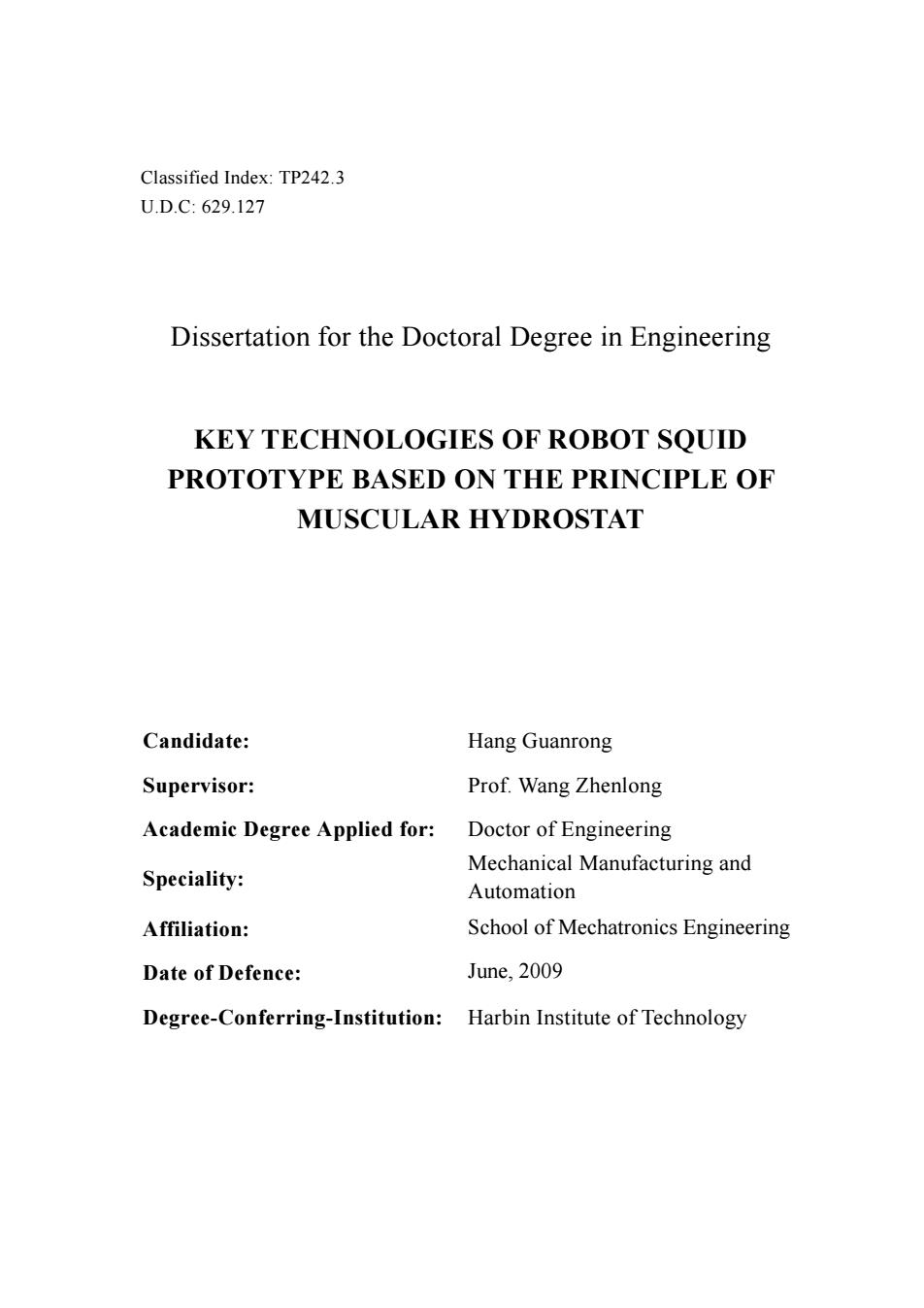
Classified Index:TP242.3 U.D.C:629.127 Dissertation for the Doctoral Degree in Engineering KEY TECHNOLOGIES OF ROBOT SQUID PROTOTYPE BASED ON THE PRINCIPLE OF MUSCULAR HYDROSTAT Candidate: Hang Guanrong Supervisor: Prof.Wang Zhenlong Academic Degree Applied for: Doctor of Engineering Mechanical Manufacturing and Speciality: Automation Affiliation: School of Mechatronics Engineering Date of Defence: June,2009 Degree-Conferring-Institution:Harbin Institute of Technology
Classified Index: TP242.3 U.D.C: 629.127 Dissertation for the Doctoral Degree in Engineering KEY TECHNOLOGIES OF ROBOT SQUID PROTOTYPE BASED ON THE PRINCIPLE OF MUSCULAR HYDROSTAT Candidate: Hang Guanrong Supervisor: Prof. Wang Zhenlong Academic Degree Applied for: Doctor of Engineering Speciality: Mechanical Manufacturing and Automation Affiliation: School of Mechatronics Engineering Date of Defence: June, 2009 Degree-Conferring-Institution: Harbin Institute of Technology

摘要 摘 要 在地球资源日趋紧张的21世纪,海洋资源日益凸显战略意义。水下机器 人(Unmanned underwater vehicle,UUV)是人类探索、开发和保护海洋资源的 重要工具。螺旋桨推进的水下机器人存在流体推进效率低、动作不灵活、噪音 大、桨叶会伤害海洋动物等问题。针对这些问题,游动仿生水下机器人如机器 鱼应运而生,但它们耐压能力较低。软体动物乌贼凭借喷射和鳍波动的高效、 灵活的复合游动方式,成功地与鱼类竞技海洋:它们依靠肌肉性静水骨骼,活 跃于从上千米的深海至海平面的广阔海域。肌肉性静水骨骼是由在三维方向上 紧密排列的肌肉纤维和结缔组织纤维构成,没有硬骨骼,但能支撑身体、产生 动作和输出力,具有不可压缩、耐高压等性质。本文提出的形状记忆合金 (Shape memory alloy,SMA)驱动的机器乌贼原型,模拟乌贼的复合游动方 式,其仿外套膜、仿乌贼鳍、仿进水膜、腕鳍等准柔性动作结构基于肌肉性静 水骨骼原理,具有耐高压的能力。 对乌贼的游动机理和外套膜、鳍这两个乌贼游动关键部件的肌肉性静水骨 骼结构进行了研究。通过解剖太平洋褶柔鱼(短鳍乌贼),获得了乌贼身体结构 参数。基于肌肉性静水骨骼原理,对简化鳍横截面和外套膜段横截面进行了建 模和分析。乌贼在低速游动时,喷射和鳍波动频率均不高,与SMA的动作频 率相接近;乌贼鳍横肌应变很小,外套膜外径应变在-8%左右,与SMA的最 大应变相接近。这些发现为研制机器乌贼原型提供了可能。该原型的动作结构 采用动物的弹性机制来提高能量利用率。 身体和/或尾鳍模式(Body and/,or caudal fin propulsion,BCF)和鳐科模式推 进的动物的游动动作较为复杂,模拟较为困难,但若将前者沿着身体方向、后 者沿着鳍宽度方向划分成足够多的小单元,将每个单元的动作简化为向左右柔 性弯曲,则通过将这些弯曲单元串联或并联组合即能重现相应的游动动作。基 于这一设想,研制了模拟乌贼鳍结构的柔性鳍单元,SMA丝模拟横肌,在动 作过程中模拟动物的弹性机制存储和释放弹性能,减小能量消耗。结合SMA 的Brinson本构模型建立了柔性鳍单元的弯曲动作理论模型。实验表明柔性鳍 单元可在空气中和水中实现柔性弯曲和回复的动作。柔性鳍单元具有弯曲角度 大、结构简单、质量小、输出力大、动作无声和模块化等优点。 通过研制采用一个柔性鳍单元的尾鳍推进微型机器鱼,验证了柔性鳍单元 用于水下推进的可行性。该机器鱼长146mm(采用仿鲫鱼型尾鳍时),质量约 -1-
摘 要 - I - 摘 要 在地球资源日趋紧张的 21 世纪,海洋资源日益凸显战略意义。水下机器 人(Unmanned underwater vehicle,UUV)是人类探索、开发和保护海洋资源的 重要工具。螺旋桨推进的水下机器人存在流体推进效率低、动作不灵活、噪音 大、桨叶会伤害海洋动物等问题。针对这些问题,游动仿生水下机器人如机器 鱼应运而生,但它们耐压能力较低。软体动物乌贼凭借喷射和鳍波动的高效、 灵活的复合游动方式,成功地与鱼类竞技海洋;它们依靠肌肉性静水骨骼,活 跃于从上千米的深海至海平面的广阔海域。肌肉性静水骨骼是由在三维方向上 紧密排列的肌肉纤维和结缔组织纤维构成,没有硬骨骼,但能支撑身体、产生 动作和输出力,具有不可压缩、耐高压等性质。本文提出的形状记忆合金 (Shape memory alloy,SMA)驱动的机器乌贼原型,模拟乌贼的复合游动方 式,其仿外套膜、仿乌贼鳍、仿进水膜、腕鳍等准柔性动作结构基于肌肉性静 水骨骼原理,具有耐高压的能力。 对乌贼的游动机理和外套膜、鳍这两个乌贼游动关键部件的肌肉性静水骨 骼结构进行了研究。通过解剖太平洋褶柔鱼(短鳍乌贼),获得了乌贼身体结构 参数。基于肌肉性静水骨骼原理,对简化鳍横截面和外套膜段横截面进行了建 模和分析。乌贼在低速游动时,喷射和鳍波动频率均不高,与 SMA 的动作频 率相接近;乌贼鳍横肌应变很小,外套膜外径应变在-8%左右,与 SMA 的最 大应变相接近。这些发现为研制机器乌贼原型提供了可能。该原型的动作结构 采用动物的弹性机制来提高能量利用率。 身体和/或尾鳍模式(Body and/or caudal fin propulsion,BCF)和鳐科模式推 进的动物的游动动作较为复杂,模拟较为困难,但若将前者沿着身体方向、后 者沿着鳍宽度方向划分成足够多的小单元,将每个单元的动作简化为向左右柔 性弯曲,则通过将这些弯曲单元串联或并联组合即能重现相应的游动动作。基 于这一设想,研制了模拟乌贼鳍结构的柔性鳍单元,SMA 丝模拟横肌,在动 作过程中模拟动物的弹性机制存储和释放弹性能,减小能量消耗。结合 SMA 的 Brinson 本构模型建立了柔性鳍单元的弯曲动作理论模型。实验表明柔性鳍 单元可在空气中和水中实现柔性弯曲和回复的动作。柔性鳍单元具有弯曲角度 大、结构简单、质量小、输出力大、动作无声和模块化等优点。 通过研制采用一个柔性鳍单元的尾鳍推进微型机器鱼,验证了柔性鳍单元 用于水下推进的可行性。该机器鱼长 146 mm(采用仿鲫鱼型尾鳍时),质量约
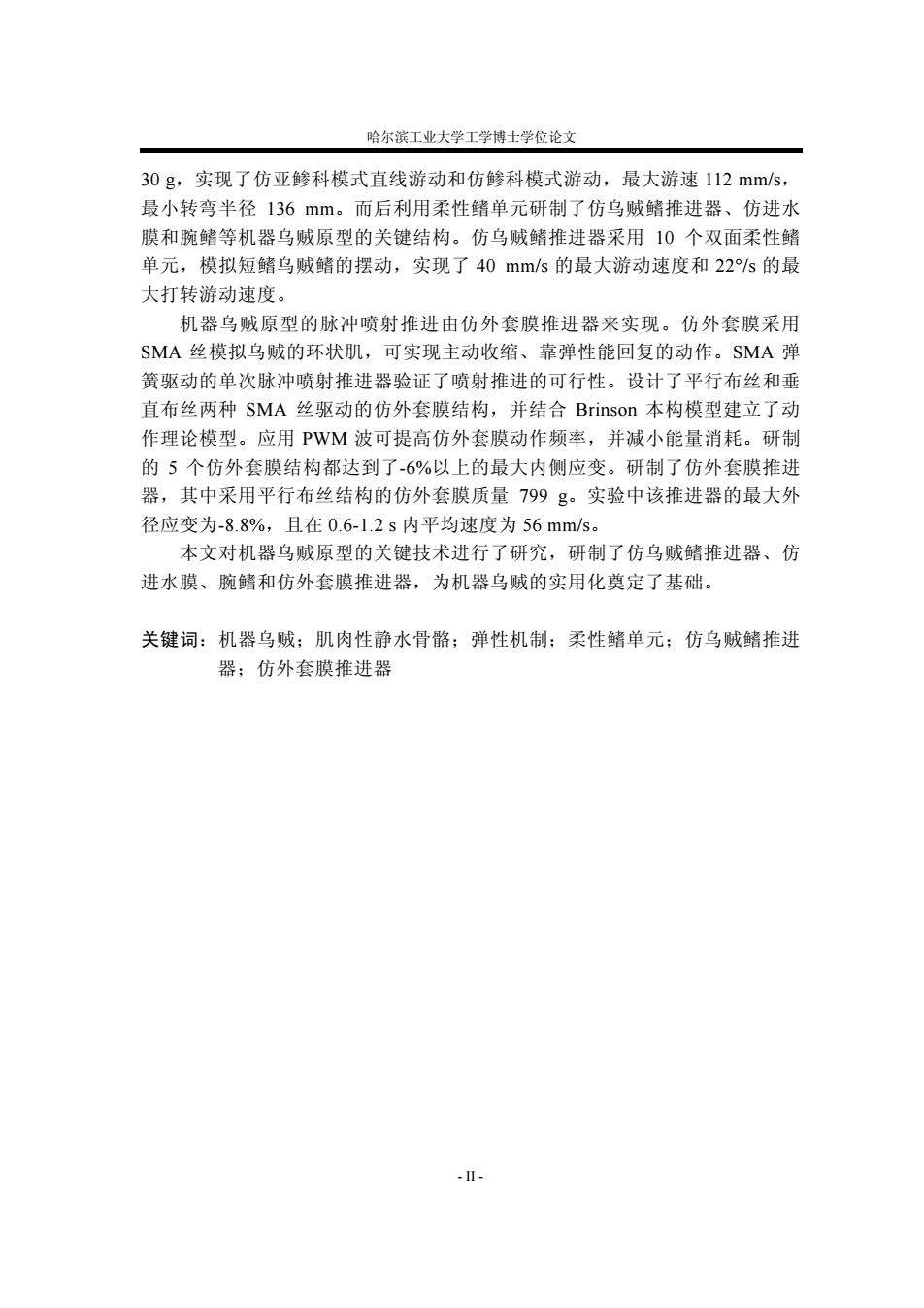
哈尔滨工业大学工学博士学位论文 30g,实现了仿亚鲹科模式直线游动和仿鲹科模式游动,最大游速112mm/s, 最小转弯半径136mm。而后利用柔性鳍单元研制了仿乌贼鳍推进器、仿进水 膜和腕鳍等机器乌贼原型的关键结构。仿乌贼鳍推进器采用10个双面柔性鳍 单元,模拟短鳍乌贼鳍的摆动,实现了40mm/s的最大游动速度和22°/s的最 大打转游动速度。 机器乌贼原型的脉冲喷射推进由仿外套膜推进器来实现。仿外套膜采用 SMA丝模拟乌贼的环状肌,可实现主动收缩、靠弹性能回复的动作。SMA弹 簧驱动的单次脉冲喷射推进器验证了喷射推进的可行性。设计了平行布丝和垂 直布丝两种SMA丝驱动的仿外套膜结构,并结合Brinson本构模型建立了动 作理论模型。应用PWM波可提高仿外套膜动作频率,并减小能量消耗。研制 的5个仿外套膜结构都达到了-6%以上的最大内侧应变。研制了仿外套膜推进 器,其中采用平行布丝结构的仿外套膜质量799g。实验中该推进器的最大外 径应变为-8.8%,且在0.6-1.2s内平均速度为56mm/s。 本文对机器乌贼原型的关键技术进行了研究,研制了仿乌贼鳍推进器、仿 进水膜、腕鳍和仿外套膜推进器,为机器乌贼的实用化奠定了基础。 关键词:机器乌贼:肌肉性静水骨骼:弹性机制:柔性鳍单元:仿乌贼鳍推进 器:仿外套膜推进器 --
哈尔滨工业大学工学博士学位论文 - II - 30 g,实现了仿亚鲹科模式直线游动和仿鲹科模式游动,最大游速 112 mm/s, 最小转弯半径 136 mm。而后利用柔性鳍单元研制了仿乌贼鳍推进器、仿进水 膜和腕鳍等机器乌贼原型的关键结构。仿乌贼鳍推进器采用 10 个双面柔性鳍 单元,模拟短鳍乌贼鳍的摆动,实现了 40 mm/s 的最大游动速度和 22°/s 的最 大打转游动速度。 机器乌贼原型的脉冲喷射推进由仿外套膜推进器来实现。仿外套膜采用 SMA 丝模拟乌贼的环状肌,可实现主动收缩、靠弹性能回复的动作。SMA 弹 簧驱动的单次脉冲喷射推进器验证了喷射推进的可行性。设计了平行布丝和垂 直布丝两种 SMA 丝驱动的仿外套膜结构,并结合 Brinson 本构模型建立了动 作理论模型。应用 PWM 波可提高仿外套膜动作频率,并减小能量消耗。研制 的 5 个仿外套膜结构都达到了-6%以上的最大内侧应变。研制了仿外套膜推进 器,其中采用平行布丝结构的仿外套膜质量 799 g。实验中该推进器的最大外 径应变为-8.8%,且在 0.6-1.2 s 内平均速度为 56 mm/s。 本文对机器乌贼原型的关键技术进行了研究,研制了仿乌贼鳍推进器、仿 进水膜、腕鳍和仿外套膜推进器,为机器乌贼的实用化奠定了基础。 关键词:机器乌贼;肌肉性静水骨骼;弹性机制;柔性鳍单元;仿乌贼鳍推进 器;仿外套膜推进器
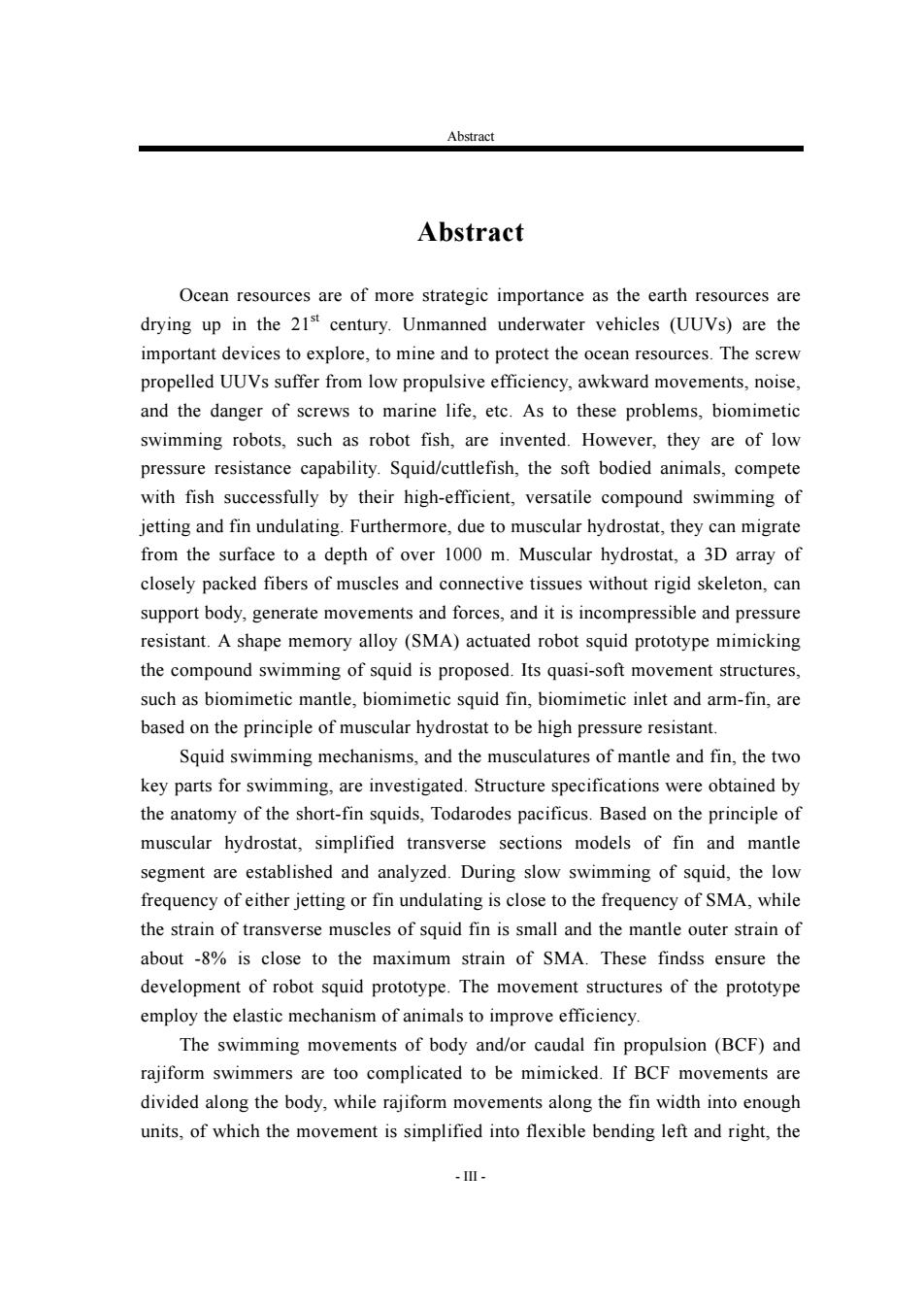
Abstract Abstract Ocean resources are of more strategic importance as the earth resources are drying up in the 21st century.Unmanned underwater vehicles (UUVs)are the important devices to explore,to mine and to protect the ocean resources.The screw propelled UUVs suffer from low propulsive efficiency,awkward movements,noise, and the danger of screws to marine life,etc.As to these problems,biomimetic swimming robots,such as robot fish,are invented.However,they are of low pressure resistance capability.Squid/cuttlefish,the soft bodied animals,compete with fish successfully by their high-efficient,versatile compound swimming of jetting and fin undulating.Furthermore,due to muscular hydrostat,they can migrate from the surface to a depth of over 1000 m.Muscular hydrostat,a 3D array of closely packed fibers of muscles and connective tissues without rigid skeleton,can support body,generate movements and forces,and it is incompressible and pressure resistant.A shape memory alloy(SMA)actuated robot squid prototype mimicking the compound swimming of squid is proposed.Its quasi-soft movement structures, such as biomimetic mantle,biomimetic squid fin,biomimetic inlet and arm-fin,are based on the principle of muscular hydrostat to be high pressure resistant. Squid swimming mechanisms,and the musculatures of mantle and fin,the two key parts for swimming,are investigated.Structure specifications were obtained by the anatomy of the short-fin squids,Todarodes pacificus.Based on the principle of muscular hydrostat,simplified transverse sections models of fin and mantle segment are established and analyzed.During slow swimming of squid,the low frequency of either jetting or fin undulating is close to the frequency of SMA,while the strain of transverse muscles of squid fin is small and the mantle outer strain of about -8%is close to the maximum strain of SMA.These findss ensure the development of robot squid prototype.The movement structures of the prototype employ the elastic mechanism of animals to improve efficiency. The swimming movements of body and/or caudal fin propulsion (BCF)and rajiform swimmers are too complicated to be mimicked.If BCF movements are divided along the body,while rajiform movements along the fin width into enough units,of which the movement is simplified into flexible bending left and right,the -Ⅲ-
Abstract - III - Abstract Ocean resources are of more strategic importance as the earth resources are drying up in the 21st century. Unmanned underwater vehicles (UUVs) are the important devices to explore, to mine and to protect the ocean resources. The screw propelled UUVs suffer from low propulsive efficiency, awkward movements, noise, and the danger of screws to marine life, etc. As to these problems, biomimetic swimming robots, such as robot fish, are invented. However, they are of low pressure resistance capability. Squid/cuttlefish, the soft bodied animals, compete with fish successfully by their high-efficient, versatile compound swimming of jetting and fin undulating. Furthermore, due to muscular hydrostat, they can migrate from the surface to a depth of over 1000 m. Muscular hydrostat, a 3D array of closely packed fibers of muscles and connective tissues without rigid skeleton, can support body, generate movements and forces, and it is incompressible and pressure resistant. A shape memory alloy (SMA) actuated robot squid prototype mimicking the compound swimming of squid is proposed. Its quasi-soft movement structures, such as biomimetic mantle, biomimetic squid fin, biomimetic inlet and arm-fin, are based on the principle of muscular hydrostat to be high pressure resistant. Squid swimming mechanisms, and the musculatures of mantle and fin, the two key parts for swimming, are investigated. Structure specifications were obtained by the anatomy of the short-fin squids, Todarodes pacificus. Based on the principle of muscular hydrostat, simplified transverse sections models of fin and mantle segment are established and analyzed. During slow swimming of squid, the low frequency of either jetting or fin undulating is close to the frequency of SMA, while the strain of transverse muscles of squid fin is small and the mantle outer strain of about -8% is close to the maximum strain of SMA. These findss ensure the development of robot squid prototype. The movement structures of the prototype employ the elastic mechanism of animals to improve efficiency. The swimming movements of body and/or caudal fin propulsion (BCF) and rajiform swimmers are too complicated to be mimicked. If BCF movements are divided along the body, while rajiform movements along the fin width into enough units, of which the movement is simplified into flexible bending left and right, the
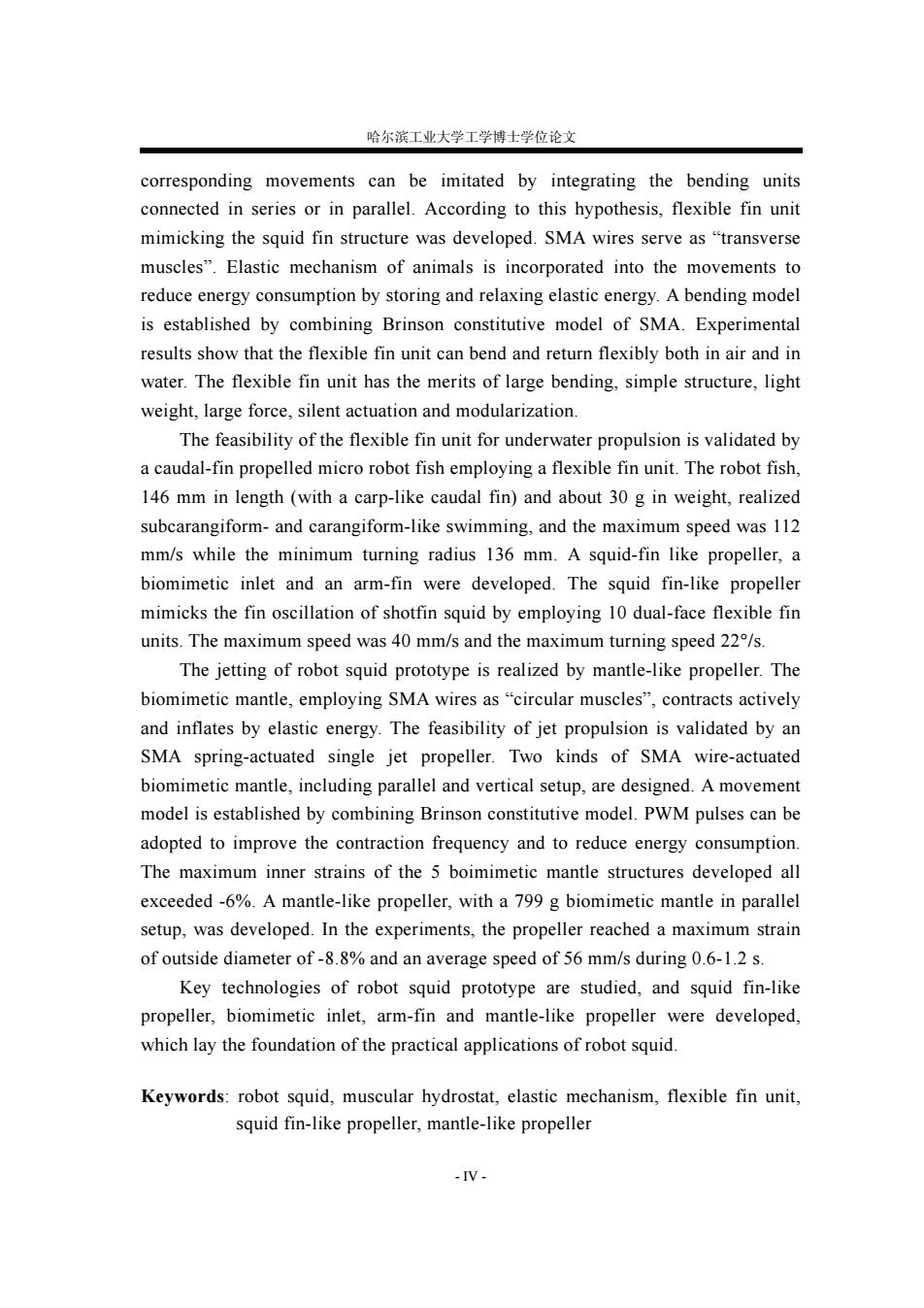
哈尔滨工业大学工学博士学位论文 corresponding movements can be imitated by integrating the bending units connected in series or in parallel.According to this hypothesis,flexible fin unit mimicking the squid fin structure was developed.SMA wires serve as "transverse muscles".Elastic mechanism of animals is incorporated into the movements to reduce energy consumption by storing and relaxing elastic energy.A bending model is established by combining Brinson constitutive model of SMA.Experimental results show that the flexible fin unit can bend and return flexibly both in air and in water.The flexible fin unit has the merits of large bending,simple structure,light weight,large force,silent actuation and modularization. The feasibility of the flexible fin unit for underwater propulsion is validated by a caudal-fin propelled micro robot fish employing a flexible fin unit.The robot fish, 146 mm in length (with a carp-like caudal fin)and about 30 g in weight,realized subcarangiform-and carangiform-like swimming,and the maximum speed was 112 mm/s while the minimum turning radius 136 mm.A squid-fin like propeller,a biomimetic inlet and an arm-fin were developed.The squid fin-like propeller mimicks the fin oscillation of shotfin squid by employing 10 dual-face flexible fin units.The maximum speed was 40 mm/s and the maximum turning speed 22/s The jetting of robot squid prototype is realized by mantle-like propeller.The biomimetic mantle,employing SMA wires as"circular muscles",contracts actively and inflates by elastic energy.The feasibility of jet propulsion is validated by an SMA spring-actuated single jet propeller.Two kinds of SMA wire-actuated biomimetic mantle,including parallel and vertical setup,are designed.A movement model is established by combining Brinson constitutive model.PWM pulses can be adopted to improve the contraction frequency and to reduce energy consumption. The maximum inner strains of the 5 boimimetic mantle structures developed all exceeded-6%.A mantle-like propeller,with a 799 g biomimetic mantle in parallel setup,was developed.In the experiments,the propeller reached a maximum strain of outside diameter of-8.8%and an average speed of 56 mm/s during 0.6-1.2 s. Key technologies of robot squid prototype are studied,and squid fin-like propeller,biomimetic inlet,arm-fin and mantle-like propeller were developed, which lay the foundation of the practical applications of robot squid. Keywords:robot squid,muscular hydrostat,elastic mechanism,flexible fin unit, squid fin-like propeller,mantle-like propeller -V-
哈尔滨工业大学工学博士学位论文 - IV - corresponding movements can be imitated by integrating the bending units connected in series or in parallel. According to this hypothesis, flexible fin unit mimicking the squid fin structure was developed. SMA wires serve as “transverse muscles”. Elastic mechanism of animals is incorporated into the movements to reduce energy consumption by storing and relaxing elastic energy. A bending model is established by combining Brinson constitutive model of SMA. Experimental results show that the flexible fin unit can bend and return flexibly both in air and in water. The flexible fin unit has the merits of large bending, simple structure, light weight, large force, silent actuation and modularization. The feasibility of the flexible fin unit for underwater propulsion is validated by a caudal-fin propelled micro robot fish employing a flexible fin unit. The robot fish, 146 mm in length (with a carp-like caudal fin) and about 30 g in weight, realized subcarangiform- and carangiform-like swimming, and the maximum speed was 112 mm/s while the minimum turning radius 136 mm. A squid-fin like propeller, a biomimetic inlet and an arm-fin were developed. The squid fin-like propeller mimicks the fin oscillation of shotfin squid by employing 10 dual-face flexible fin units. The maximum speed was 40 mm/s and the maximum turning speed 22°/s. The jetting of robot squid prototype is realized by mantle-like propeller. The biomimetic mantle, employing SMA wires as “circular muscles”, contracts actively and inflates by elastic energy. The feasibility of jet propulsion is validated by an SMA spring-actuated single jet propeller. Two kinds of SMA wire-actuated biomimetic mantle, including parallel and vertical setup, are designed. A movement model is established by combining Brinson constitutive model. PWM pulses can be adopted to improve the contraction frequency and to reduce energy consumption. The maximum inner strains of the 5 boimimetic mantle structures developed all exceeded -6%. A mantle-like propeller, with a 799 g biomimetic mantle in parallel setup, was developed. In the experiments, the propeller reached a maximum strain of outside diameter of -8.8% and an average speed of 56 mm/s during 0.6-1.2 s. Key technologies of robot squid prototype are studied, and squid fin-like propeller, biomimetic inlet, arm-fin and mantle-like propeller were developed, which lay the foundation of the practical applications of robot squid. Keywords: robot squid, muscular hydrostat, elastic mechanism, flexible fin unit, squid fin-like propeller, mantle-like propeller
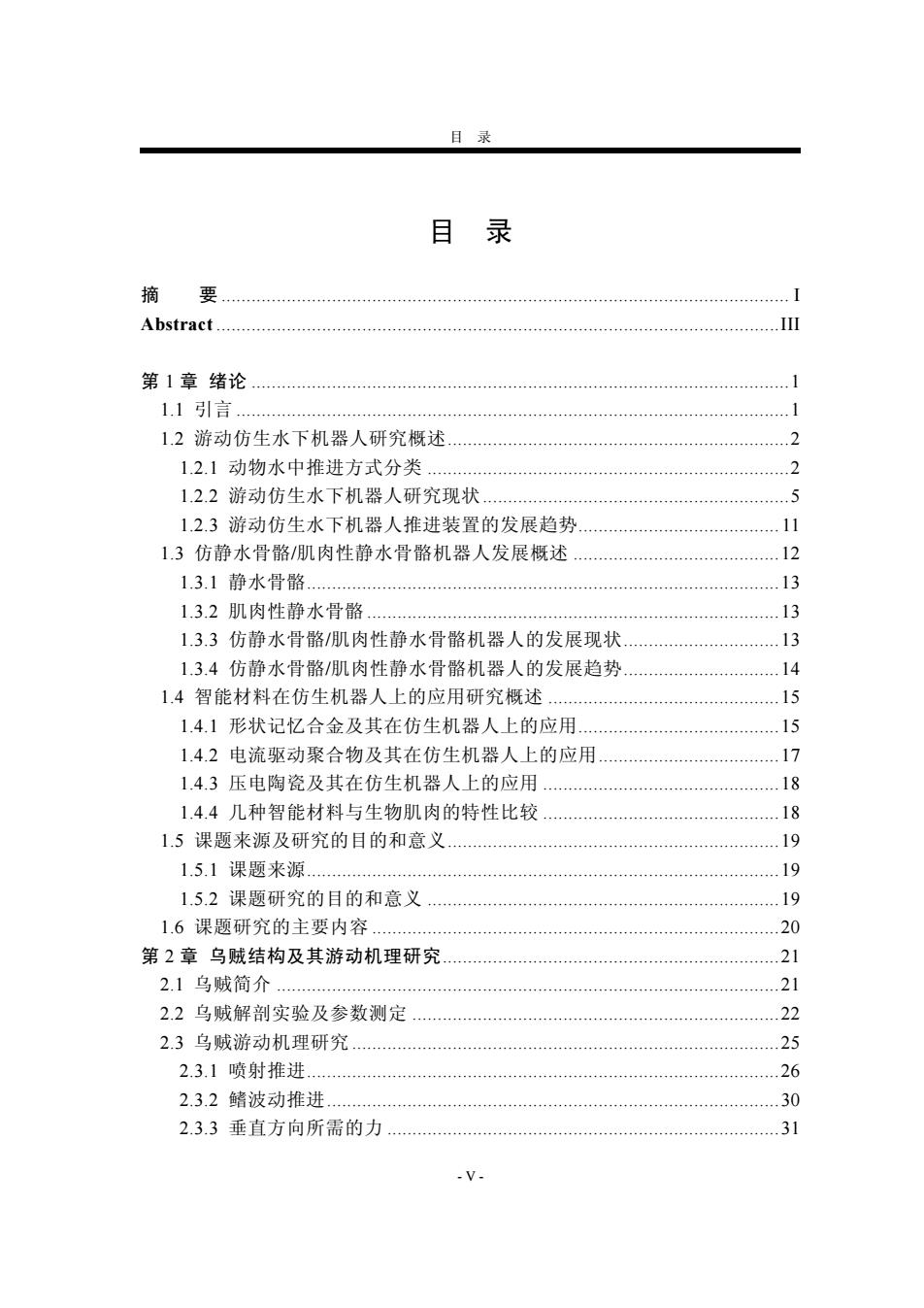
目录 目 录 摘 要 … Abstract. .11 第1章绪论 4… 1.1引言… 1 1.2游动仿生水下机器人研究概述 2 1.2.1动物水中推进方式分类 … 2 1.2.2游动仿生水下机器人研究现状 5 1.2.3游动仿生水下机器人推进装置的发展趋势 .11 1.3仿静水骨骼/肌肉性静水骨骼机器人发展概述 。。 12 1.3.1静水骨骼… .13 1.3.2肌肉性静水骨骼.… 13 1.3.3仿静水骨骼/肌肉性静水骨骼机器人的发展现状 。。, 13 1.3.4仿静水骨骼/肌肉性静水骨骼机器人的发展趋势 14 1.4智能材料在仿生机器人上的应用研究概述 15 1.4.1形状记忆合金及其在仿生机器人上的应用 15 1.4.2电流驱动聚合物及其在仿生机器人上的应用 17 1.4.3压电陶瓷及其在仿生机器人上的应用 18 1.4.4几种智能材料与生物肌肉的特性比较 18 1.5课题来源及研究的目的和意义 … 19 1.5.1课题来源 19 1.5.2课题研究的目的和意义… 19 1.6课题研究的主要内容 20 第2章乌贼结构及其游动机理研究 。。。。。。。。。。。。。。。。。。 21 2.1乌贼简介 21 2.2乌贼解剖实验及参数测定 22 2.3乌贼游动机理研究…...… 25 2.3.1喷射推进. 26 2.3.2鳍波动推进 .30 2.3.3垂直方向所需的力31 .V-
目 录 - V - 目 录 摘 要 ................................................................................................................. I Abstract ................................................................................................................III 第 1 章 绪论 ...........................................................................................................1 1.1 引言 ..............................................................................................................1 1.2 游动仿生水下机器人研究概述....................................................................2 1.2.1 动物水中推进方式分类 ........................................................................2 1.2.2 游动仿生水下机器人研究现状.............................................................5 1.2.3 游动仿生水下机器人推进装置的发展趋势........................................ 11 1.3 仿静水骨骼/肌肉性静水骨骼机器人发展概述 .........................................12 1.3.1 静水骨骼..............................................................................................13 1.3.2 肌肉性静水骨骼 ..................................................................................13 1.3.3 仿静水骨骼/肌肉性静水骨骼机器人的发展现状...............................13 1.3.4 仿静水骨骼/肌肉性静水骨骼机器人的发展趋势...............................14 1.4 智能材料在仿生机器人上的应用研究概述 ..............................................15 1.4.1 形状记忆合金及其在仿生机器人上的应用........................................15 1.4.2 电流驱动聚合物及其在仿生机器人上的应用....................................17 1.4.3 压电陶瓷及其在仿生机器人上的应用 ...............................................18 1.4.4 几种智能材料与生物肌肉的特性比较 ...............................................18 1.5 课题来源及研究的目的和意义..................................................................19 1.5.1 课题来源..............................................................................................19 1.5.2 课题研究的目的和意义 ......................................................................19 1.6 课题研究的主要内容 .................................................................................20 第 2 章 乌贼结构及其游动机理研究...................................................................21 2.1 乌贼简介 ....................................................................................................21 2.2 乌贼解剖实验及参数测定 .........................................................................22 2.3 乌贼游动机理研究 .....................................................................................25 2.3.1 喷射推进..............................................................................................26 2.3.2 鳍波动推进..........................................................................................30 2.3.3 垂直方向所需的力 ..............................................................................31
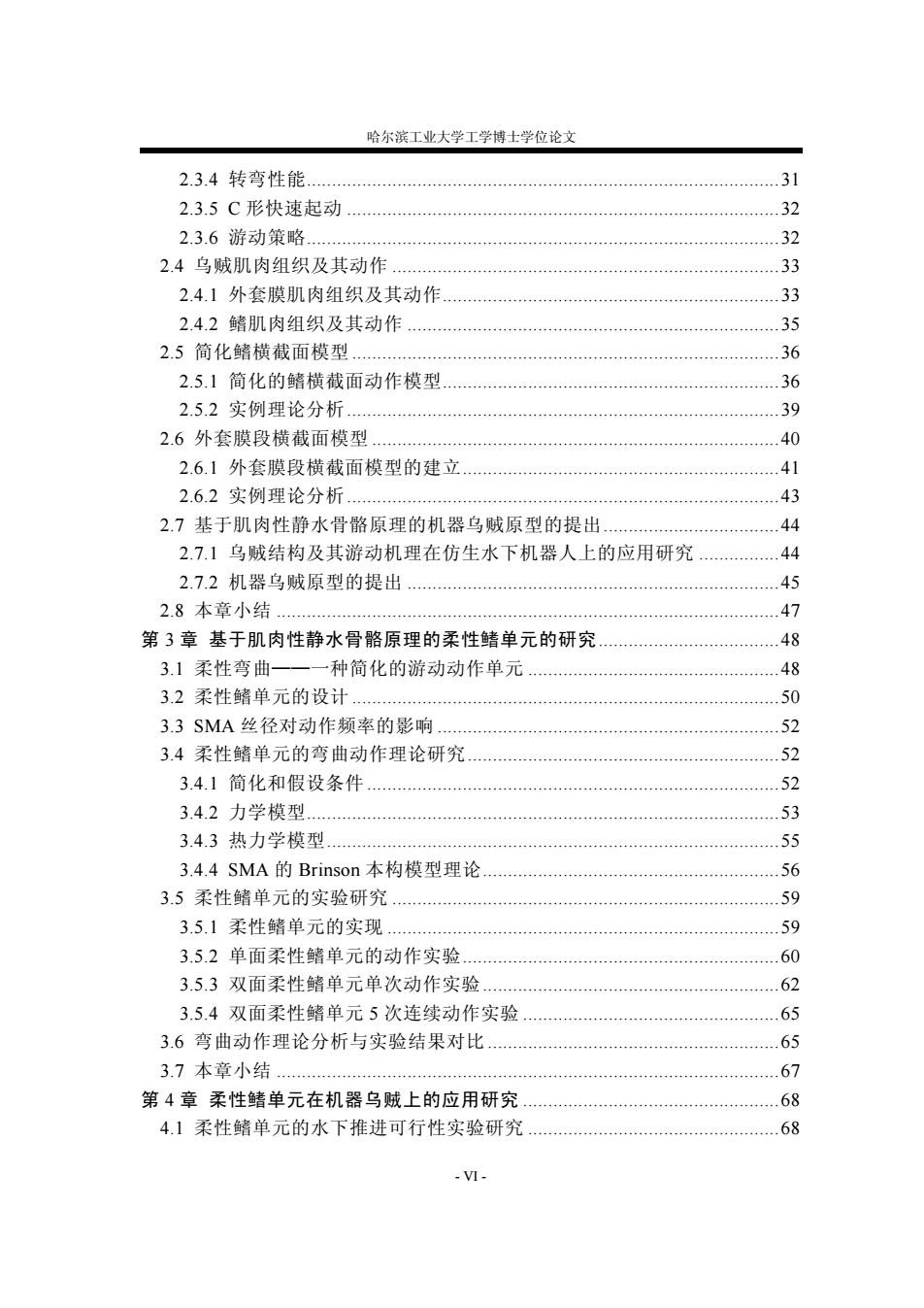
哈尔滨工业大学工学博士学位论文 2.3.4转弯性能 .31 2.3.5C形快速起动 32 2.3.6游动策略 32 2.4乌贼肌肉组织及其动作 33 2.4.1外套膜肌肉组织及其动作 33 2.4.2鳍肌肉组织及其动作 。。。。。。。。。。。。 .35 2.5简化鳍横截面模型 36 2.5.1简化的鳍横截面动作模型 36 2.5.2实例理论分析. 39 2.6外套膜段横截面模型 40 2.6.1外套膜段横截面模型的建立41 2.6.2实例理论分析. 43 2.7基于肌肉性静水骨骼原理的机器乌贼原型的提出 .44 2.7.1乌贼结构及其游动机理在仿生水下机器人上的应用研究 44 2.7.2机器乌贼原型的提出45 2.8本章小结 47 第3章基于肌肉性静水骨骼原理的柔性鳍单元的研究 ..48 3.1柔性弯曲一一一种简化的游动动作单元 48 3.2柔性鳍单元的设计… 50 3.3SMA丝径对动作频率的影响 52 3.4柔性鳍单元的弯曲动作理论研究… 52 3.4.1简化和假设条件 52 3.4.2力学模型. 53 3.4.3热力学模型 55 3.4.4SMA的Brinson本构模型理论 56 3.5柔性鳍单元的实验研究 59 3.5.1柔性鳍单元的实现 59 3.5.2单面柔性鳍单元的动作实验.… 60 3.5.3双面柔性鳍单元单次动作实验 62 3.5.4双面柔性鳍单元5次连续动作实验 65 3.6弯曲动作理论分析与实验结果对比 65 3.7本章小结. 67 第4章柔性鳍单元在机器乌贼上的应用研究 68 4.1柔性鳍单元的水下推进可行性实验研究 .68 -VI-
哈尔滨工业大学工学博士学位论文 - VI - 2.3.4 转弯性能..............................................................................................31 2.3.5 C 形快速起动 ......................................................................................32 2.3.6 游动策略..............................................................................................32 2.4 乌贼肌肉组织及其动作 .............................................................................33 2.4.1 外套膜肌肉组织及其动作...................................................................33 2.4.2 鳍肌肉组织及其动作 ..........................................................................35 2.5 简化鳍横截面模型 .....................................................................................36 2.5.1 简化的鳍横截面动作模型...................................................................36 2.5.2 实例理论分析......................................................................................39 2.6 外套膜段横截面模型 .................................................................................40 2.6.1 外套膜段横截面模型的建立...............................................................41 2.6.2 实例理论分析......................................................................................43 2.7 基于肌肉性静水骨骼原理的机器乌贼原型的提出...................................44 2.7.1 乌贼结构及其游动机理在仿生水下机器人上的应用研究 ................44 2.7.2 机器乌贼原型的提出 ..........................................................................45 2.8 本章小结 ....................................................................................................47 第 3 章 基于肌肉性静水骨骼原理的柔性鳍单元的研究....................................48 3.1 柔性弯曲——一种简化的游动动作单元 ..................................................48 3.2 柔性鳍单元的设计 .....................................................................................50 3.3 SMA 丝径对动作频率的影响 ....................................................................52 3.4 柔性鳍单元的弯曲动作理论研究..............................................................52 3.4.1 简化和假设条件 ..................................................................................52 3.4.2 力学模型..............................................................................................53 3.4.3 热力学模型..........................................................................................55 3.4.4 SMA 的 Brinson 本构模型理论...........................................................56 3.5 柔性鳍单元的实验研究 .............................................................................59 3.5.1 柔性鳍单元的实现 ..............................................................................59 3.5.2 单面柔性鳍单元的动作实验...............................................................60 3.5.3 双面柔性鳍单元单次动作实验...........................................................62 3.5.4 双面柔性鳍单元 5 次连续动作实验 ...................................................65 3.6 弯曲动作理论分析与实验结果对比..........................................................65 3.7 本章小结 ....................................................................................................67 第 4 章 柔性鳍单元在机器乌贼上的应用研究 ...................................................68 4.1 柔性鳍单元的水下推进可行性实验研究 ..................................................68
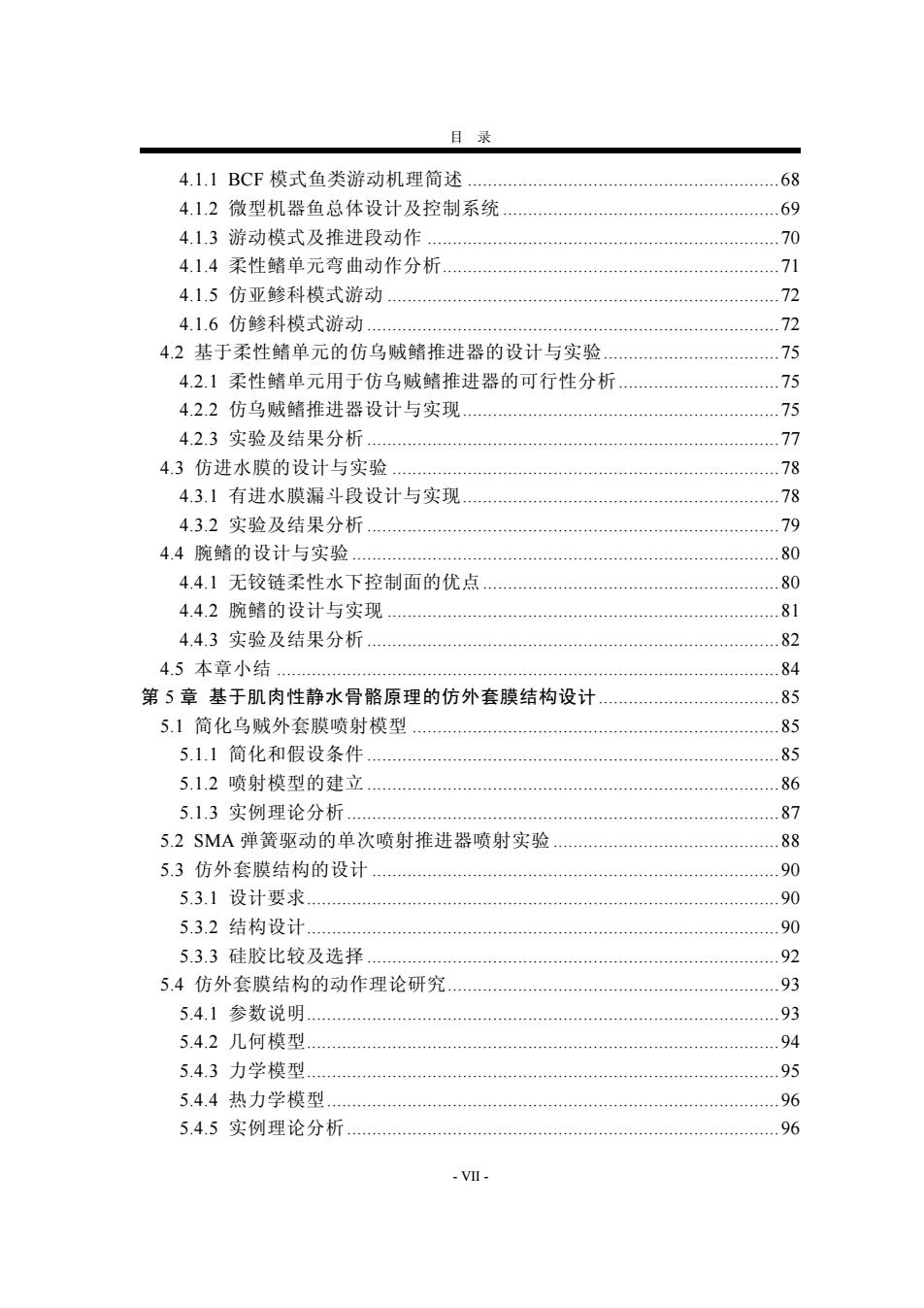
目录 4.1.1BCF模式鱼类游动机理简述 .68 4.1.2微型机器鱼总体设计及控制系统 69 4.1.3游动模式及推进段动作 70 4.1.4柔性鳍单元弯曲动作分析 .71 4.1.5仿亚鲹科模式游动 72 4.1.6仿鲹科模式游动..72 4.2基于柔性鳍单元的仿乌贼鳍推进器的设计与实验 75 4.2.1柔性鳍单元用于仿乌贼鳍推进器的可行性分析 75 4.2.2仿乌贼鳍推进器设计与实现 75 4.2.3实验及结果分析 77 4.3仿进水膜的设计与实验 78 4.3.1有进水膜漏斗段设计与实现 78 4.3.2实验及结果分析 。。 .79 4.4腕鳍的设计与实验 .… 80 4.4.1无铰链柔性水下控制面的优点 80 4.4.2腕鳍的设计与实现 4.4.3实验及结果分析.. .82 4.5本章小结.… 84 第5章基于肌肉性静水骨骼原理的仿外套膜结构设计 85 5.1简化乌贼外套膜喷射模型 85 5.1.1简化和假设条件 85 5.1.2喷射模型的建立 86 5.1.3实例理论分析 87 5.2SMA弹簧驱动的单次喷射推进器喷射实验… 88 5.3仿外套膜结构的设计 90 5.3.1设计要求 90 5.3.2结构设计 90 5.3.3硅胶比较及选择 92 5.4仿外套膜结构的动作理论研究 93 5.4.1参数说明 93 5.4.2几何模型 94 5.4.3力学模型 95 5.4.4热力学模型 .96 5.4.5实例理论分析96 VII
目 录 - VII - 4.1.1 BCF 模式鱼类游动机理简述 ..............................................................68 4.1.2 微型机器鱼总体设计及控制系统 .......................................................69 4.1.3 游动模式及推进段动作 ......................................................................70 4.1.4 柔性鳍单元弯曲动作分析...................................................................71 4.1.5 仿亚鲹科模式游动 ..............................................................................72 4.1.6 仿鲹科模式游动 ..................................................................................72 4.2 基于柔性鳍单元的仿乌贼鳍推进器的设计与实验...................................75 4.2.1 柔性鳍单元用于仿乌贼鳍推进器的可行性分析................................75 4.2.2 仿乌贼鳍推进器设计与实现...............................................................75 4.2.3 实验及结果分析 ..................................................................................77 4.3 仿进水膜的设计与实验 .............................................................................78 4.3.1 有进水膜漏斗段设计与实现...............................................................78 4.3.2 实验及结果分析 ..................................................................................79 4.4 腕鳍的设计与实验 .....................................................................................80 4.4.1 无铰链柔性水下控制面的优点...........................................................80 4.4.2 腕鳍的设计与实现 ..............................................................................81 4.4.3 实验及结果分析 ..................................................................................82 4.5 本章小结 ....................................................................................................84 第 5 章 基于肌肉性静水骨骼原理的仿外套膜结构设计....................................85 5.1 简化乌贼外套膜喷射模型 .........................................................................85 5.1.1 简化和假设条件 ..................................................................................85 5.1.2 喷射模型的建立 ..................................................................................86 5.1.3 实例理论分析......................................................................................87 5.2 SMA 弹簧驱动的单次喷射推进器喷射实验 .............................................88 5.3 仿外套膜结构的设计 .................................................................................90 5.3.1 设计要求..............................................................................................90 5.3.2 结构设计..............................................................................................90 5.3.3 硅胶比较及选择 ..................................................................................92 5.4 仿外套膜结构的动作理论研究..................................................................93 5.4.1 参数说明..............................................................................................93 5.4.2 几何模型..............................................................................................94 5.4.3 力学模型..............................................................................................95 5.4.4 热力学模型..........................................................................................96 5.4.5 实例理论分析......................................................................................96
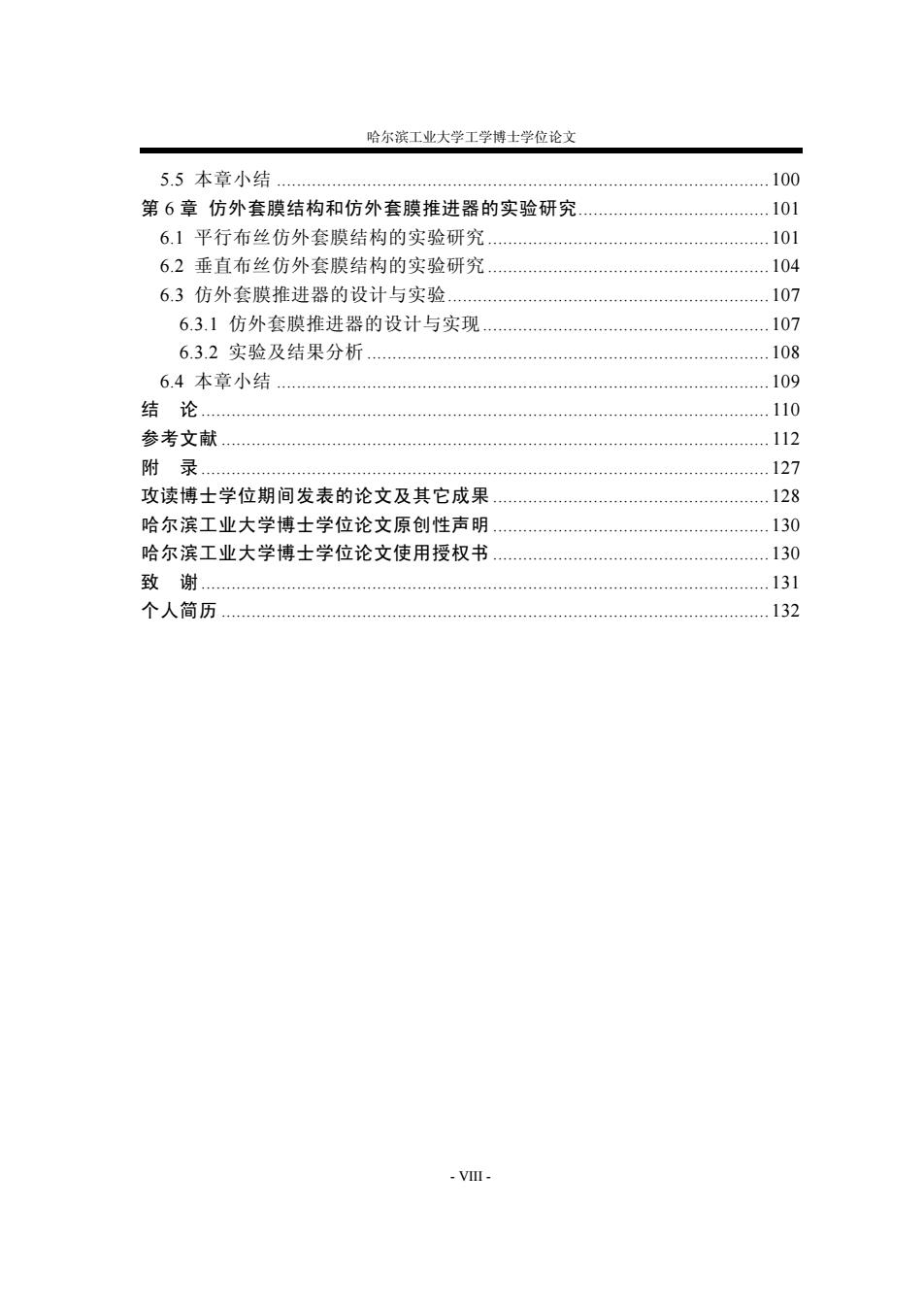
哈尔滨工业大学工学博士学位论文 5.5本章小结 100 第6章仿外套膜结构和仿外套膜推进器的实验研究 101 6.1平行布丝仿外套膜结构的实验研究 101 6.2垂直布丝仿外套膜结构的实验研究 104 6.3仿外套膜推进器的设计与实验 107 6.3.1仿外套膜推进器的设计与实现 107 6.3.2实验及结果分析 108 6.4本章小结 109 结论 110 参考文献.… 112 附录 127 攻读博士学位期间发表的论文及其它成果 128 哈尔滨工业大学博士学位论文原创性声明 130 哈尔滨工业大学博士学位论文使用授权书 。。。。。。 130 致谢.… 131 个人简历 132
哈尔滨工业大学工学博士学位论文 - VIII - 5.5 本章小结 ..................................................................................................100 第 6 章 仿外套膜结构和仿外套膜推进器的实验研究......................................101 6.1 平行布丝仿外套膜结构的实验研究........................................................101 6.2 垂直布丝仿外套膜结构的实验研究........................................................104 6.3 仿外套膜推进器的设计与实验................................................................107 6.3.1 仿外套膜推进器的设计与实现.........................................................107 6.3.2 实验及结果分析 ................................................................................108 6.4 本章小结 ..................................................................................................109 结 论................................................................................................................. 110 参考文献 ............................................................................................................. 112 附 录.................................................................................................................127 攻读博士学位期间发表的论文及其它成果 .......................................................128 哈尔滨工业大学博士学位论文原创性声明 .......................................................130 哈尔滨工业大学博士学位论文使用授权书 .......................................................130 致 谢.................................................................................................................131 个人简历 .............................................................................................................132